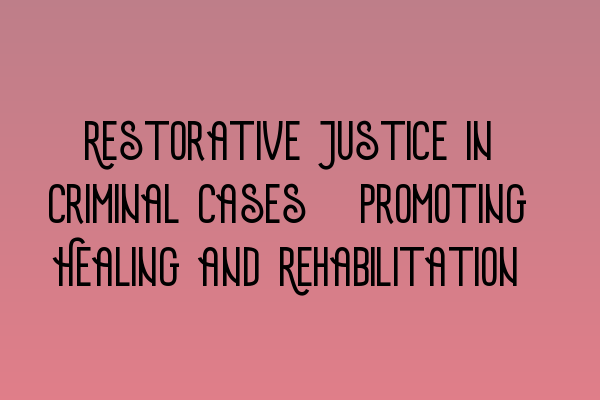Restorative Justice in Criminal Cases: Promoting Healing and Rehabilitation
In recent years, there has been a growing recognition of the limitations of traditional criminal justice systems. The focus on punishment and retribution has often led to a cycle of violence and recidivism, without addressing the underlying causes of criminal behavior. As a result, alternative approaches such as restorative justice have gained traction, offering a more holistic and rehabilitative approach to dealing with crime.
Restorative justice is a process that aims to repair the harm caused by crime by involving all stakeholders – victims, offenders, and the community – in a participatory dialogue. Rather than simply punishing the offender, restorative justice encourages them to take responsibility for their actions, make amends, and work towards reintegrating into society.
The Benefits of Restorative Justice
Restorative justice offers numerous benefits over traditional punitive approaches. One of the key advantages is its focus on healing and rehabilitation. By involving victims in the resolution process, restorative justice gives them a voice and empowers them to express their needs, emotions, and concerns.
Moreover, studies have shown that victims who participate in restorative justice programs report higher levels of satisfaction and a greater sense of closure than those who only engage with the formal criminal justice system. This sense of closure can be crucial in helping victims move forward and overcome trauma.
For offenders, restorative justice provides an opportunity for personal growth and rehabilitation. By engaging in dialogue with their victims and understanding the impact of their actions, offenders are more likely to develop empathy and take responsibility for their behavior. This can lead to a greater likelihood of successful reintegration into society and a reduced risk of reoffending.
The Role of Restorative Justice in Criminal Cases
Restorative justice can be applied at various stages of the criminal justice process. In pre-trial or diversion programs, restorative justice practices can be used as an alternative to formal prosecution or incarceration. Offenders may be given the opportunity to meet with their victims, apologize, and agree on a plan to repair the harm caused.
During sentencing, restorative justice can be used to inform the judge’s decision, taking into account the wishes of the victim and the offender’s commitment to making amends. This can result in more tailored and rehabilitative sentences, rather than the one-size-fits-all approach of traditional sentencing.
Even during imprisonment, restorative justice practices can be utilized to foster healing and rehabilitation. Offenders can participate in victim-offender dialogues, community service, and educational programs aimed at developing their skills and addressing the underlying issues that led to their criminal behavior.
Implementing Restorative Justice
While restorative justice shows great promise, its implementation is not without challenges. One key obstacle is the need for adequate resources and training. Restorative justice programs require skilled facilitators who can guide the process, ensure the safety of participants, and promote meaningful dialogue.
Additionally, there is a need for public education and awareness to overcome skepticism and misconceptions about restorative justice. Many people are unfamiliar with the concept and may view it as a soft approach that prioritizes the needs of the offender over those of the victim. Clear and accurate information about the benefits and principles of restorative justice is crucial to gain support and establish its legitimacy.
SQE 1 Practice Mocks FLK1 FLK2
Restorative justice in criminal cases holds great potential for promoting healing and rehabilitation. By involving victims, offenders, and the community in the resolution process, restorative justice offers a more inclusive and effective approach to addressing the harm caused by crime. Through dialogue, empathy, and personal growth, restorative justice can break the cycle of reoffending, create safer communities, and restore trust in the criminal justice system.
